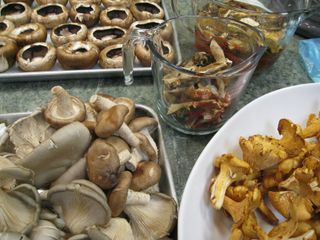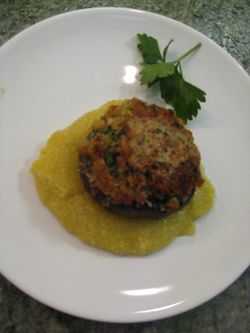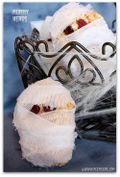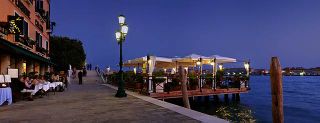American shoppers are accustomed to getting any food
they want at the supermarket any time of year. Raspberries in the dead of
winter? South America’s gotcha
covered. White asparagus in October? Hothouse varieties to the rescue.
 But somehow the mushroom plays by different rules. Sure, you can
get cultivated white mushrooms, also known as button mushrooms, year round.
Shiitake enoki, and cremini , too. But there are many types of mushrooms that can only be found deep
in the woods, and only during the autumn months. Mushroom connoisseurs swear by the more intense, interesting and rewarding flavor of wild mushrooms, and go crazy each
fall when treasures like the chanterelle ( a trumpet-shaped, delicately
flavored mushroom that has never been successfully cultivated) hit the produce
stands.
But somehow the mushroom plays by different rules. Sure, you can
get cultivated white mushrooms, also known as button mushrooms, year round.
Shiitake enoki, and cremini , too. But there are many types of mushrooms that can only be found deep
in the woods, and only during the autumn months. Mushroom connoisseurs swear by the more intense, interesting and rewarding flavor of wild mushrooms, and go crazy each
fall when treasures like the chanterelle ( a trumpet-shaped, delicately
flavored mushroom that has never been successfully cultivated) hit the produce
stands.
Nadia Frigeri is one of those mushroom lovers. The
accomplished cooking teacher and
European food tour guide, taught a “mushroom” class last week at San
Diego’s Cooking with Class Cooking School. My son, Ben, gave me the class as a birthday gift and went
with me.
We arrived to find Nadia elbow deep in six or seven types of
mushrooms. As she sorted, washed, chopped and sautéed, the animated cook shared valuable
information and delicious recipes.
She also shared her passion. I probably haven’t cooked a mushroom in my
kitchen in five years It’s just not an ingredient that I often have a hankering
for. But this week, armed with my new “skills” and Nadia’s
user-friendly recipes, I’m taking full advantage of the season.
Valuable tidbits from Nadia Frigeri :
*** With chanterelles, cut off only the tiniest bit of dark, hard edge. Every other part of
the mushroom is edible and easy to clean. Bugs don’t like chanterelles.
*** Generally speaking it’s better to wash mushrooms quickly
in a bowl of water than wipe them with a cloth or mushroom brush. Chanterelles
can sit in the water for a few minutes; spongier types of mushrooms
should be removed quickly before they absorb too much water.
*** Portobello mushrooms and the smaller portobellini are
best grilled or broiled whole.
*** Do not use tough shiitake stems in cooking. They are
good only for mushroom broth.
*** Don’t store mushrooms in plastic bags. They will sweat
and lose their water content.
*** Fontina cheese is ideal for cooking because it melts
evenly, unlike other cheeses that separate into a fat puddle and a chewy glob.
*** Cut cooled polenta into squares or discs with dental
floss, not a knife.
*** Shiitake mushrooms come in two grades: Grade 1 is more
delicate, more flavorful and substantially more expensive than Grade 2.
*** Use Blue Castello, a triple-crème blue cow’s milk cheese
from Denmark, if Gorgonzola is too
costly or not available.
*** Add a large pinch of cayenne pepper when cooking polenta for a brighter flavor.
 *** San Diegans are blessed with a top-notch source of wild
and cultitvated mushrooms that cost a fraction of mushrooms in area supermarkets. Specialty Produce is a
wholesale operation that is also open to the public. The produce offerings are
extraordinary, both in terms of quality and variety. Nadia estimates that
mushrooms at Specialty Produce cost about one-third the same product at Whole
Foods.
*** San Diegans are blessed with a top-notch source of wild
and cultitvated mushrooms that cost a fraction of mushrooms in area supermarkets. Specialty Produce is a
wholesale operation that is also open to the public. The produce offerings are
extraordinary, both in terms of quality and variety. Nadia estimates that
mushrooms at Specialty Produce cost about one-third the same product at Whole
Foods.
My son and I loved Nadia’s Filet Mignon with Gorgonzola
Cheese and Mushroom Sauce, and her Baked Portobellini Mushrooms Stuffed with
Gorgonzola, Herbs and Breadcrumbs that were served on polenta (pictured here).
But it was this recipe – roasted slices of butternut squash topped with mixed mushrooms and fontina cheese – that we’ve decided to show off on our
Thanksgiving table this year.
ZUCCA E FUNGHI GRATINATI
(Roasted Butternut with Mushrooms and Fontina Cheese)
Serves 8
2-3 pounds butternut squash, peeled and cut into 3/4 –inch
slices
Salt and freshly ground pepper
Extra virgin olive oil
2 tablespoons unsalted butter
2 tablespoons extra virgin olive oil
1 to 1 ½ pounds mixed mushrooms, such as chanterelle, cremini, oyster and
shiitake
2-3 garlic cloves, crushed and chopped or 1 tablespoon
roasted garlic puree
¼ cup chopped Italian parsley leaves
½ cup chicken or vegetable broth, heated (optional)
½ cup grated Parmesan cheese or grated Swiss cheese
6-8 ounces Italian fontina or French raclette cheese,
shredded
Preheat the oven to 375 degrees. Place the butternut squash slices on a large piece of
parchment paper on a baking sheet, season with salt and pepper and drizzle with
the oil. Bake for about 20 minutes or until the slices are tender but still
firm. Remove from the oven and set aside.
Arrange the squash slices on a buttered baking dish, season
with salt and pepper and sprinkle with the grated Parmesan cheese.
Quickly wash the mushrooms in a bowl of cool water. Pat dry
with paper towels.
In a medium skillet, heat the butter and remaining oil. Add mushrooms, garlic and parsley. Stir
until the mushrooms start to soften and the garlic starts to color. Season with
salt and pepper. Add broth, if desired, and cook for 3 or 4 minutes.
Spoon the cooked mushroom mixture over the squash slices,
top with shredded fontina cheese and bake for about 15 minutes, or until cheese
starts to bubble.
 "Thirty Minute Pasta: 100 Quick and Easy Recipe," gives
new meaning to the term No-Brainer.
"Thirty Minute Pasta: 100 Quick and Easy Recipe," gives
new meaning to the term No-Brainer. Fusilli with Zucchini and Mint (right) was delicious, its “sauce” of
perfumed olive oil and a couple tablespoons of pasta water amazingly creamy. So
was the Fusilli with Butternut Squash that is quintessential autumn comfort
food. (I added grilled chicken to the leftovers, topped it all with shredded
mozzarella and toasted pinenuts and baked it 15 minutes for another fast and
easy dinner.)
Fusilli with Zucchini and Mint (right) was delicious, its “sauce” of
perfumed olive oil and a couple tablespoons of pasta water amazingly creamy. So
was the Fusilli with Butternut Squash that is quintessential autumn comfort
food. (I added grilled chicken to the leftovers, topped it all with shredded
mozzarella and toasted pinenuts and baked it 15 minutes for another fast and
easy dinner.)






